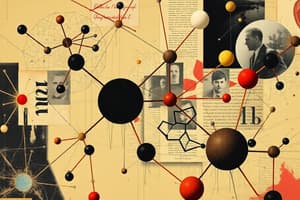Podcast
Questions and Answers
What does the coordination number of a coordination compound represent?
What does the coordination number of a coordination compound represent?
Which of the following is NOT a common ligand in coordination compounds?
Which of the following is NOT a common ligand in coordination compounds?
Crystal Field Theory is associated with the interaction between:
Crystal Field Theory is associated with the interaction between:
What defines isomerism in coordination compounds?
What defines isomerism in coordination compounds?
Signup and view all the answers
How do ligands bind to the central metal ion in coordination compounds?
How do ligands bind to the central metal ion in coordination compounds?
Signup and view all the answers
What does Crystal Field Theory (CFT) explain in transition metal complexes?
What does Crystal Field Theory (CFT) explain in transition metal complexes?
Signup and view all the answers
Which type of isomerism involves different connectivity patterns among ligands?
Which type of isomerism involves different connectivity patterns among ligands?
Signup and view all the answers
In Crystal Field Theory, why do d-orbitals remain unaffected by the ligand field?
In Crystal Field Theory, why do d-orbitals remain unaffected by the ligand field?
Signup and view all the answers
What causes the splitting of energy levels in Crystal Field Theory for transition metal complexes?
What causes the splitting of energy levels in Crystal Field Theory for transition metal complexes?
Signup and view all the answers
Which type of isomerism results from having mirror image arrangements of certain ligands on either side of a plane of symmetry?
Which type of isomerism results from having mirror image arrangements of certain ligands on either side of a plane of symmetry?
Signup and view all the answers
Study Notes
Coordination Compounds: A Comprehensive Overview
Coordination compounds, also known as complex compounds, are molecules where a central metal ion interacts with various types of atoms or groups called ligands. These interactions form a characteristic structure around the central metal atom. In this exploration, we'll delve into several aspects essential to understanding these fascinating entities—coordination numbers, ligands, Crystal Field Theory, and the diverse forms they can take thanks to their ability to exhibit isomers.
Coordination Number
The coordination number refers to the count of direct chemical bonds between a central metal ion and its surrounding ligands. This value provides insight into how the compound structures itself. For example:
- Zinc(II) sulfate hexahydrate has a zinc(Zn²⁺) with six oxygen atoms from water forming its coordinate bonding sphere, giving it a coordination number of 6.
- Iron(III) trichloride has iron(Fe³⁺) with three chlorine atoms attached, resulting in a coordination number of 3.
Ligands
Ligands act as electron pair donors, binding to the central metal ion through covalent bonds, leading to the formation of coordinate bonds. Some common examples include halides (Cl-, Br-, I-), hydroxide (OH-), cyanide (-CN), and ammonia (NH₃).
Crystal Field Theory (CFT)
This theory helps explain the electronic properties of transition metal complexes based on electrostatic interactions between the central metal ion and the surrounding ligand orbitals. CFT describes two energy levels split by the interaction:
- D-orbitals remain unaffected due to the spherical nature of the d-block elements.
- Paired electrons occupying lower-energy t₂₀ orbital split into higher-energy e₁ orbital and lower-energy e₅ orbital depending upon the type and strength of the ligand field generated by the ligands.
CFT plays a crucial role in explaining colorful transitions exhibited by complex compounds containing transition metals like copper and chromium.
Isomers
Isomers refer to molecular species with identical atomic compositions but different structures. They arise primarily in the realm of coordination chemistry because one compound can have multiple arrangements of ligands around the central metal ion. There are three main types of isomers related to coordination compounds:
-
Structural isomers: Different connectivity patterns among ligands result in distinct structural isomers; for instance, tetrachloridoethylene-copper complex (tetrahedral geometry versus square planar geometry).
-
Geometric isomers: Also referred to as cis-trans isomers in octahedral complexes, geometric isomers occur when there exists a plane of symmetry within the coordination polyhedron, causing the arrangement of certain ligands on either side of the plane to become mirror images of each other, such as in [Pt(en)(NH₃)₂]²⁺ (half enantiomers).
-
Optical isomers: Enantiomers or optical isomers appear the same under normal circumstances, differing only in the orientation of particular functional groups relative to the axis of chirality formed along the central metal ion, resulting in non-superimposable mirror image pairs.
In summary, coordination compounds offer an array of unique characteristics arising from variations in coordination numbers, ligands, geometries, and isomeric possibilities, providing insights into the complex behavior of materials ranging from catalysts to drugs and magnetic materials.
Studying That Suits You
Use AI to generate personalized quizzes and flashcards to suit your learning preferences.
Description
Test your knowledge on coordination compounds with this comprehensive quiz covering coordination numbers, ligands, Crystal Field Theory, and isomers. Explore the fascinating world of complex molecules where central metal ions interact with various ligands to form unique structures.




